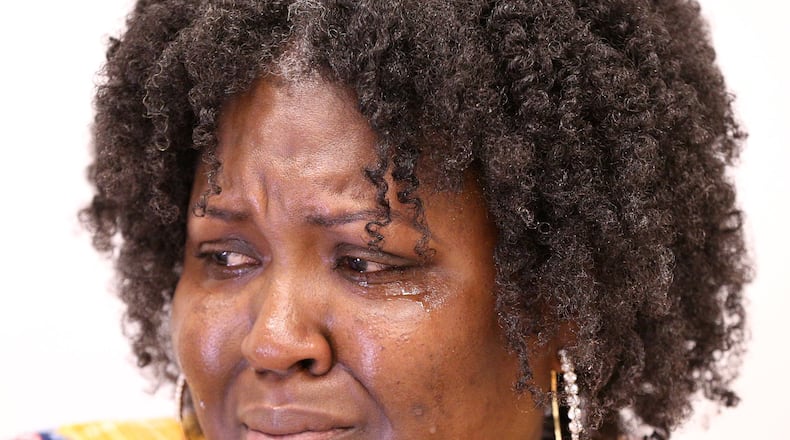Doris Adhuze saw no signs on April 21, 2017, that her son planned to take his life.
Jovany, she said, was a black teen from a two-parent household known for high-fiving friends and teachers, and quietly buying lunch for students who needed one.
Still, she found him hanging from a coat hook on his closet door about 10 minutes after the 13-year-old arrived at their Fayette County home from school that day. He died in a hospital a week later.
“It’s very hard to accept,” she said recently. “One of my relatives said, ‘This has to be an accident, because black people don’t do that.’ I was angry she said it. I said, ‘Well, we’re black, and it’s happening.’ ”
Suicides among children under 18 have spiked in recent years, and no patterns have emerged to define why more young people are taking their lives. The increase is forcing schools to get more engaged in detecting anything that could be seen as a sign that a student is planning self-harm. In recent years, schools have played a role in educating students through discussions on the subject, as well as lessons for students on detecting changes in their friends’ patterns. More recently, schools have begun utilizing technology and training teachers to spot concerning behavior and on procedures for reporting students who may be at risk. They have shown some positive results.
The number of children across the country between ages 10 and 17 who commit suicide annually has nearly doubled in the past 10 years, according to the Centers for Disease Control and Prevention.
Nationally, suicide is the second-leading cause of death for people between ages 15 and 19, according to the CDC. Twenty-six children between ages 10 and 17 have taken their lives in the state so far this year, according to the Georgia Bureau of Investigation’s Child Fatality Review Program.
More than 1,000 attempted-suicide cases were treated last year at Children’s Healthcare of Atlanta and its system facilities.
In the DeKalb County School District, at least 8 students — one per week on average — have tried to take their lives since school began in early August. Two of those reported were successful.
The district announced formal plans during its monthly meeting on Sept. 10 for all certified staff to undergo suicide-prevention training for the 2019-2020 school year, to include suicide awareness, identifying risk factors, assessing student needs and providing resources to families. Most metro Atlanta school districts have developed or are developing better strategies around suicide prevention, including tracking students' digital footprints while they are using school computers and tablets to help uncover whether they are making plans to take their lives.
“The school seems to be the safe haven for most children,” DeKalb County Board of Education member Joyce Morley said during a recent meeting. “The same way we’re feeding them food, we also have to look at those social-emotional needs.
“Something is going on, and (schools) have got to be serious about this.”
Schools stepping up their awareness efforts is welcome news to those who handle youth suicides.
“The public should be alarmed about the number of kids who have committed suicide,” said Trebor Randle, special agent in charge of the Georgia Bureau of Investigation’s Child Fatality Review unit. “Who spends more time with our kids than we do? The schools.”
Randle was frustrated delivering the figures. There is not one thing she can point out as a reason students so easily turn to suicide. She said the current generation seems to have a lower coping threshold for social pressures — sports, relationships, grades, making friends.
Her job is “to save kids,” but its focus is children after they have taken their lives.
“With my kids, I’m looking to determine what happened, how did we get here, how could we change the outcome of that kid’s life so we could save another,” she said.
Jovany was the life of the party, Adhuze said. The doorbell constantly rang with neighborhood kids wanting to hang out or stay over at the Adhuze home. The youngest of two children by several years, the precocious youth would spend his time outside in their quiet subdivision playing and even walking dogs for neighbors. On Friday nights, mother and son would curl up on the couch for movie nights.
Neighborhood dogs still find their way to the Adhuze home looking for a treat.
“I didn’t know that he knew some of these people,” she said of neighbors who reached out after Jovany’s passing.
After his death, students and teachers sent notes that featured an adjective they used to describe him. The words varied from “helpful” to “funny,” “playful” to “unique.”
White teenagers accounted for most of Georgia’s juvenile suicides so far this year, with 13 white teens between ages 15 and 17 compared to three black teens.
Ten children between ages 10 and 14 killed themselves this year.
Last year, 43 children, one as young as 9, killed themselves. In 2016 and 2015, the state had a record 51 juvenile suicides.
“It’s all over the place,” Randle said of trying to understand patterns in who’s attempting suicide. “If there was one thing to focus on, we would go (there). That’s not what’s happening. It’s moving. They’re 8. They’re 9. They’re 10.
“They’re 6 years old.”
Bryan Pearlman, a longtime educator who now travels the country doing training in trauma, behaviors and mental health, said the school district is a critical component in eventually curtailing the rise in youth suicides. Training students to detect warning signs in their friends, and training staffers to respond to patterns they see in students who come to them, goes a long way in prevention efforts, he said.
“They spend most of their time in schools,” he said of children. “In many cases, they’re going to tell that person – that critical friend, or teacher, counselor or bus driver — who’s got the boots on the ground.”
Pearlman, along with his wife and other medical and mental health professionals, started the Distinguished School of Mental Health & Wellness to train school staffs on detecting patterns and developing awareness of signs that students could be at risk of hurting themselves. Pearlman recalled an incident when he was a school administrator where a third-grade student was brought to his office by a counselor after telling another adult that life wasn’t worth living. He gave her the space to write her thoughts down. After she left, he said he found a piece of paper, folded tight, where she wrote she had nothing for which to live. He listened, he said, and it saved her life.
“I set up a structure after that, where every kid who walked past me got a fist bump, a high five, a bro hug,” he said. “It’s that one-minute, ‘How are you?’ that shows little clues. I won the lottery that day (with the third-grader). She had everything going for her and no one saw it.
“It’s the quiet, compliant kid who’s sitting there in the third row, who’s suffering in silence.”
The Jason Flatt Act, passed by Georgia in 2015, requires suicide prevention training in all districts, which typically equates to an annual hours-long seminar. Jason Flatt was a Tennessee teenager who killed himself in 1997. His parents have worked to get suicide-prevention laws passed in several states since his passing.
Some school districts go further, with monthly sessions and programs or hotlines where people can call in concerns.
Clayton County Public Schools started the See Something Say Something Tip Line for students and employees to report anything that raises a worry that someone may be planning to do themselves or others harm.
Certified staff in Gwinnett County Public Schools complete human resources compliance training, which includes a component specifically on suicide prevention. Tinisha Parker, the district’s director of advisement and counseling, said that training has taken place several years now.
“The training teaches staff potential warning signs of students who may be experiencing suicidal ideation as well as instructs staff on what to do if a student discloses self harm or suicidal thoughts,” she said.
DeKalb is utilizing technology to aid in suicide prevention. The district uses the Lightspeed application on its laptops, tablets and other district-issued devices which includes an alert system when something suspicious is entered into a device, said Chief Information Officer Gary Brantley. In the last week, the system has identified a handful of instances where someone has used a district-issued device to search for things such as “how to kill myself,” “easiest way to commit suicide” or “I want to kill myself.”
“We instantly get an alert, and we rush and go into protocol,” Brantley said.
That protocol could include calling authorities, who have responded to homes where the school-owned devices have been in use. While Lightspeed immediately alerts district officials to statements that clearly indicate danger, it also sends alerts on language that could potentially reflect a student is trying to hurt themselves. Lightspeed employees have contacted the district about things they’ve detected as well, which Brantley considers an added layer of protection.
“It’s a big help,” he said.
This month, police responded to three homes after DeKalb County School District officials received alerts that someone made searches related to suicide on district-issued devices.
“It allows us to feel a little more confident in our ability to detect these types of situations,” he said. “A lot of things take place on these devices, and kids are on them for hours a day. I sleep a whole lot better at night knowing that these types of safeguards are in place.”
A few weeks after Jovany’s death, Doris Adhuze said a staff member at Jovany’s school recalled something that could have been interpreted as a sign that something may have been amiss. The staffer lamented, after Jovany’s death, not having intruded. Adhuze said she has some of those after-the-fact moments, herself. The hardest part is still not knowing what would have led Jovany to taking his life, or whether that was what he planned in the first place.
“It was a normal day,” she said of April 21, 2017. “But I use that … because he’s not the narrative. And this is not how I want people to know him.
“He’s more than this. He’s so much more than this.”
About the Author
The Latest
Featured



